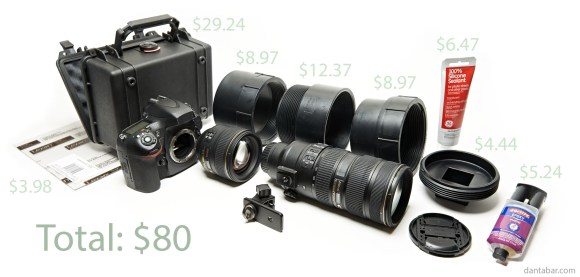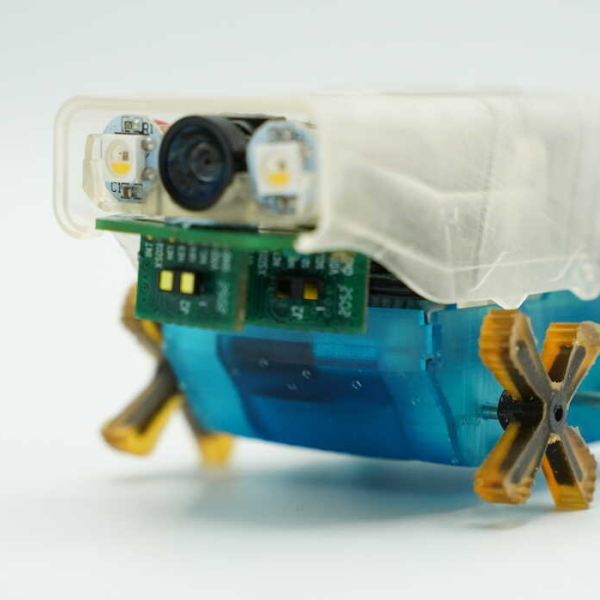
The D-SLR “crunch” sound can be pretty satisfying. Your camera has moving parts and those cell-phone amateurs can eat your shutter actuation. If you’re a professional photographer behind the scenes on a sound stage or at any film shoot, however, your mirror slapping around is loud enough to get you kicked off the set. [Dan Tábar] needed his D800 to keep it down, so he made his own sound blimp to suppress the noise. As an added bonus, it turns out the case is waterproof, too!
[Dan] got the idea from a fellow photographer who was using a prefab Jacobson blimp to snap pictures in sound-sensitive environments. Not wanting to spend $1000, he looked for a DIY alternative. This build uses a Pelican case to house the body of the camera and interchangeable extension tubes to cover lenses of various sizes. [Dan] took measurements and test-fit a paper cutout of his D800 before carving holes into the Pelican case with a Dremel tool. One side got a circular hole for the extension tubes, while the other received a rectangular cut for the camera’s LCD screen and a smaller circle for the viewfinder.
Lexan serves as a window for all of the open ends: LCD, viewfinder, and the lens. [Dan] snaps pictures with a wireless trigger, saving him the trouble of drilling another hole. You can hear the D800 before and after noise reduction in a video after the break, along with a second video of [Dan] trying out some underwater shots. If you’d rather take a trip back in time, there’s always the 3D printed pinhole camera from last week.
















Very nice! Hate to miss out on the satisfying click though ;)
Do the pelicase cutting with a cnc router and boom you’ve got a nice little market for this stuff right there!
Waterproof except for the big gaping hole in the front where the lens lives.
That’s true… if there were actually a hole in the front. But it’s not. He doesn’t do a good job of showing how he covered the lens hole, but you can tell he did if you were to watch the video.
“Lexan serves as a window for all of the open ends: LCD, viewfinder, and the lens.”
If you can read you could possibly get some info from the article.
reminds me of the Barny blimp for 16mm film cameras, they are noisy beasts… here is an example.. chamblesscineequip.com/catalog/Barney%20Blimp.htm
And also a much needed aesthetic update for that ugly Nikon body.
If it’s not limp, it’s not a blimp! That’s a rigid case if I ever saw one.
Anyway, isn’t this what mirrorless cameras are for? You know, the way electronic cameras were meant to work?
Or you could just leave the mirror up and shoot with the LCD and have no click at all :)
Or buy a EVIL camera instead…
He tried to save money by making a home-made solution, and your guess is he’s swimming in money to buy new pro cameras without mirror.
If he is making a living with photography that money might be well spent as this case looks quite bulky and hard to handle … Of course if he only needs that camera few times the diy alternative is better.
I think he may be a little optimistic in his assessment of how waterproof it is – especially if he’s comparing it to a true scuba-ready case. That window for the viewfinders looks like it’s about 4 sq. in. exposed area (rectangle plus circle openings are on the same piece of Lexan) and at 30 foot depth, that will have about 60 pounds force on it; at the rec. diver’s limit, it would be about 240 lb. I haven’t tried using adhesives on any of my peli-boxes, so I can’t say how well it bonds to, say silicone sealant, but I’d be pretty cautious.
His use of Teflon tape on the screw-seal lens opening would not be too trustworthy if my experience with large diameter PVC pipe is anything to go on.
IOW – if you copy this, do some serious testing with nothing expensive in the case before committing something you don’t want to lose to it.
I guess the case is made to sustain rain, not scuba diving… And I would try the seal very carefully before even housing my oldish Canon SX-10 inside it.
I really don’t think anybody will use this for deep diving, it’s more for standing in the pool without losing it when you accidentally drop it in the water.
Still, can’t harm to mention it. Oh and I’m not sure how bad PVC tubing sealing is, it’s used for most of the drainage and sewage on the planet without too much incident after all.
If you have a low enough standard for leakage, PVC threads are fine. They don’t operate under much pressure in plumbing drains.
I mentioned my concerns because he actually said that he would consider this case for snorkelling and maybe scuba.
The most basic test for anything waterproof is 1 metre for 30 minutes (IPX7). This case was tested for something closer to IPX3 or 4.
Handy info you give there, that’s the kind of stuff people can use.
whats worse is he used silicone as an adhesive. you can’t even do that with a lexan window at 1 ATM, the thing can just fall off on its own! 3m 5200 is an actual waterproof adhesive, and it would likely stand up to diving-level PSI
Is this Pelican 1120?
I would not use lexan for the lens window. Lexan is tough but soft and scratches very, very easily, If you have ever looked at a motorcycle or airplane windscreen in the sun you will see it.
A piece of acrylic would be better or just get the biggest UV filter you can for the lens.
I can’t turn off the obnoxious noise that my Android phone makes, even though the instructions show it’s possible. The stupidity of noises added where none exist.
Because some countries (like mine) don’t want you to be sneaky with your photos. So you have to have some sound (unless you root your phone and replace soundfile with empty one)
Yeah, I have a mirrorless Olympus with the same problem: no way to kill the sound effect.